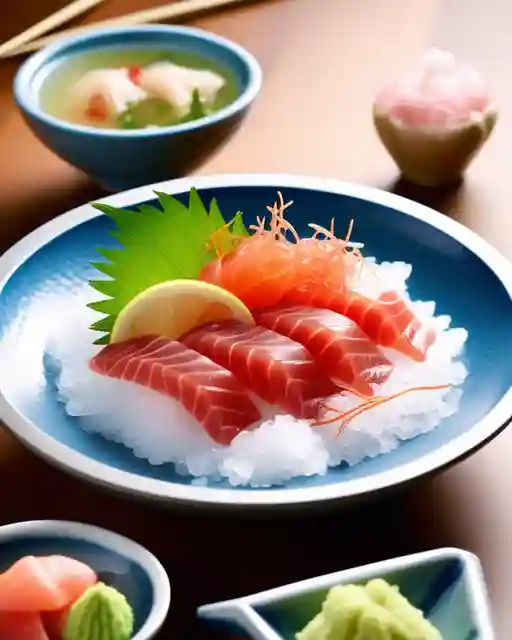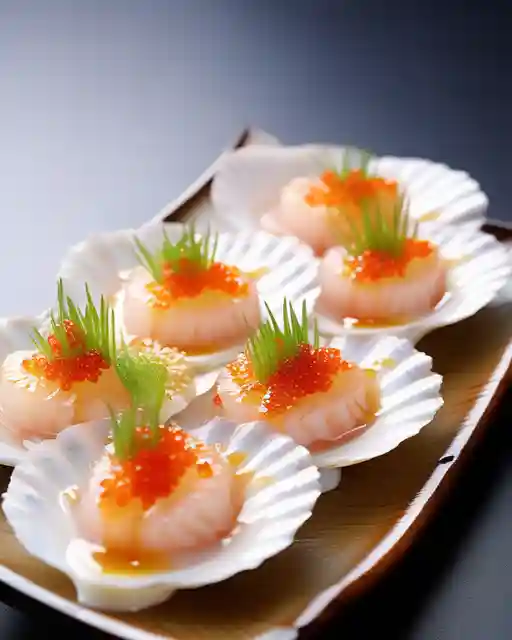What’s Sashimi 101: Japan’s Signature Raw Seafood Dishes
Updated: 04 Aug 2023
185

It’s raw fish sliced really thin and served with soy sauce. Sashimi might seem weird if you’ve never tried it before. But it’s actually a super yummy dish! Let’s we’ll learn everything about sashimi so you can become an expert.
What Exactly is Sashimi?
Sashimi starts with the freshest fish, straight from the sea. In Japan, it’s served with soy sauce, spicy wasabi, and pickled ginger. The ginger helps refresh your mouth between sashimi pieces. Sashimi chefs use amazing knife skills to slice the fish perfectly.
History of Sashimi
The tradition of eating sashimi in Japan is very old. Back in the 1300s and 1500s, rich people served sashimi at celebrations. Only they could enjoy it. Later, When people invented trains and ice boxes, they could bring fish from the coasts to the cities. This allowed more people to try sashimi!
In the 1960s, sashimi really became popular in Japanese restaurants. By the 1980s, sashimi had started gaining fans all around the world. But to this day, sashimi still tastes best in Japan!
Popular Types of Sashimi
1. Sake (Salmon) Sashimi:

Sake refers to salmon sashimi, prized for its bright orange-pink hue. It has a silky, smooth texture and a rich, buttery taste.
The best sake comes from wild-caught Pacific salmon.
They slice it thinly against the grain and often season it with lemon juice or yuzu kosho.
2. Maguro (Bluefin Tuna) Sashimi:
Maguro specifically refers to bluefin tuna sashimi, the most prized variety in Japan.
Its ruby-red flesh is fatty, soft, and melts in the mouth. Maguro has a sweet, delicate flavor. Overfishing has decreased bluefin populations.
3. Katsuo (Bonito) Sashimi:
Katsuo refers to bonito, a fish in the tuna family.
It has a firm texture and robust, savory umami flavor. Katsuo is a very common sashimi choice in Japan.
Sashimi chefs slice it from the lean pink/red flesh along the back of the fish. Katsuo has a higher fat content than skipjack tuna, giving it a slightly creamy mouthfeel.
4. Hotate (Scallops) Sashimi:

Hotate are sashimi-grade scallops known for their brilliantly sweet and saline flavor.
They have a delicate texture and soft orange roe that contrast nicely.
5. Ebi (Shrimp) Sashimi:
Ebi is sweet, tender shrimp sliced into thin sashimi.
Their thin layers create a delicate mouthfeel. Ebi has a mildly sweet flavor and often comes with the shell and tail intact for presentation.
6. Ahi (Yellowfin Tuna) Sashimi:

Ahi refers to sashimi from yellowfin tuna, noted for its deep red color.
It has a smooth texture and a mild flavor. Ahi needs little seasoning beyond soy sauce and wasabi. It offers an excellent source of omega-3 fatty acids.
7. Hokkigai (Surf Clam) Sashimi:
Hokkigai is sashimi made from surf clam flesh.
It has a chewy texture and a mildly briny, oceanic flavor. The coral-red color of hokkigai makes it visually striking.
They serve it in a fan-shaped shell.
8. Ika (Squid) Sashimi:

Ika refers to raw squid sliced for sashimi.
It has a creamy, opaque white color and a chewy, resilient texture. Ika sashimi offers a mildly sweet flavor with umami undertones.
How to Make Sashimi
Here is a detailed guide on how to make sashimi at home:
1. Selecting Fish:
- Choose ultra-fresh, sashimi-grade fish. The best options are tuna, salmon, yellowtail, scallops, and mackerel.
- Ensure the fish was previously frozen to the required temperatures to kill parasites.
- Look for clear eyes, bright red gills, and firm flesh that springs back when pressed.
- Avoid fish with dull eyes and/or dried-out or mushy flesh.
2. Prep the Fish for Sashimi:
- Clean fish thoroughly – Rinse under cold, running water to remove impurities
- Fillet fish – Use a sharp, thin knife to slice off skin/bones
- Cut blocks – Trim fillets into 1-2” thick rectangular blocks
- Arrange fish blocks – On a plate, covered with plastic wrap
- Refrigerate – Chill fish for 30 minutes to firm up
3. Slice the Sashimi:
- Remove chilled fish from the fridge
- Cut very thin slices – About 1⁄4 inch thick
- Slice at a 45° angle – Against the grain for the best texture
- Smooth, translucent slices – Even size and shape
- Arrange slices gently – On a chilled plate without overlapping
4. Finishing Touches:
- Garnish sashimi with microgreens, edible flowers, lemon slices, etc.
- Provide soy sauce, wasabi, and pickled ginger as dipping condiments.
- You may drizzle sashimi lightly with ponzu, olive oil, or yuzu kosho.
- For safety, serve sashimi immediately and store any leftovers for at least 24 hours.
- Enjoy sashimi with chopsticks, and dip pieces briefly in soy sauce with wasabi.
How to Eat Sashimi

Here is a detailed guide on how to properly eat and enjoy sashimi:
1. Use Chopsticks:
- Sashimi is traditionally eaten with chopsticks in Japan. Use wooden or lacquered chopsticks if available.
- Hold the top chopstick like a pencil between your index and middle fingers.
- Rest the bottom chopstick against your ring finger and manipulate it with your thumb.
2. Cut Bite-Sized Pieces:
- Do not grab large pieces of sashimi with your fingers. Use chopsticks to cut manageable bite-sized pieces.
- Bring your plate close to your mouth as you eat for proper etiquette.
3. Dip in Soy Sauce:
- Only dip a small corner of the sashimi into soy sauce so you can first taste the pure flavor of the fish.
- Never submerge the whole piece in soy sauce or leave it sitting in the dish too long.
4. Add Wasabi:
- Add a small amount of wasabi to the soy sauce dish and stir before dipping the sashimi.
- You can also place wasabi directly on the fish if you prefer stronger wasabi flavors.
5. Eat in One Bite:
- Place the entire piece of sashimi in your mouth at once after dipping. Do not bite off pieces of it.
- Savor the taste and texture before chewing lightly 2-3 times and swallowing.
6. Complementary Items:
- Gari (pickled ginger) cleanses the palate between different types of sashimi.
- Sip green tea or Japanese beer to complement the flavors.
- You may add a few grains of rice or seaweed salad between sashimi for contrast.
7. Proper Etiquette:
- Eat at a moderate pace, and do not talk with your mouth full.
- Slurping noises are acceptable and normal when savoring sashimi.
- Clean hands with a damp towel provided before and after the meal.
Where to Eat Sashimi
- In Japan, sushi and kaiseki restaurants often serve the first course.
- At Japanese steakhouses or hibachi grills alongside rice dishes and appetizers.
- High-end seafood restaurants prepare freshly caught fish.
- All you can eat sushi restaurants are available, though the cuts and quality may vary.
- Pre-made sashimi platters from grocery stores are extremely fresh.
Health Benefits of Sashimi
Here are some of the major health benefits of eating sashimi:
High-Quality Protein:
Sashimi provides complete, easily digestible protein needed for muscle growth, tissue repair, and supporting an active lifestyle. The fish in sashimi has all the essential amino acids.
Omega-3 Fatty Acids:
Fatty fish used in sashimi, like salmon and tuna, contain the anti-inflammatory omega-3s EPA and DHA. These promote heart health, brain function, healthy aging, and lower triglycerides.
Low Fat:
The lean cuts of fish in sashimi contain much less saturated fat than many other protein sources, like red meat. This helps reduce the risk of high cholesterol.
Rich in Micronutrients:
Sashimi provides B vitamins, selenium, iodine, magnesium, and potassium, which regulate metabolism, thyroid function, electrolyte balance, and nerve signaling.
High in Vitamin D:
The natural oils in fatty fish supply vitamin D, which is crucial for calcium absorption and bone health. Many people are deficient in vitamin D.
Low Carb:
With no cooking oils, breading, or sauces, sashimi is low in carbohydrates compared to many dishes. This makes it favorable for weight loss or diabetic diets.
Low Sodium:
Plain sashimi contains only around 40 mg of sodium per serving. The optional soy sauce dipping sauce does add more sodium, though.
Easy to Digest:
The thin slices of sashimi are much easier to break down than densely cooked meat. This makes sashimi gentle on sensitive digestive systems.
Anti-Inflammatory:
Compounds like astaxanthin found in seafood are linked to reducing inflammation throughout the body and providing antioxidant protection.
Final Thoughts
- Sashimi is a refined delicacy that is an important part of Japanese culinary tradition. When skillfully sliced and presented, this fresh, raw seafood dish allows one to appreciate the pure, delicate flavors and textures of premium seafood. The preparation of sashimi relies heavily on the freshness and quality of the ingredients.
- Just-caught, sashimi-grade fish and shellfish provide the melt-in-your-mouth texture and clean taste that make sashimi prized.
- Beyond flavor, the nutritional merits of sashimi are immense. The lean protein is easy to digest, the omega-3 fatty acids benefit heart health, and the low-carb, low-calorie nature makes it ideal for diets.
- However, people must take care to source sashimi fish from sustainable fisheries to prevent depleting aquatic ecosystems.
- From the elegant knife work involved in slicing the fish to the subtle flavors and artful presentation, sashimi encapsulates the refinement and attention to detail of Japanese cuisine. It has now become a global delicacy after originating in Japan centuries ago.
- Though simple, sushi chefs treat each piece of nigiri or slice of sashimi with immense care and respect. When enjoyed properly, sashimi provides a taste of the freshness and vibrancy of the sea.
FAQs about Sashimi
What is the difference between sushi and sashimi?
Sushi includes vinegared rice, while sashimi is just sliced seafood. Sashimi is often served at sushi restaurants and paired with sushi dishes. Both are delicious Japanese seafood dishes!
Is sushi halal?
Some types are halal, but generally, sushi is not considered halal due to the rice wine vinegar.
What exactly is sashimi?
Sashimi is fresh, raw seafood sliced into thin pieces and served with soy sauce.
What is nigiri vs. sashimi?
Sushi chefs slice fish over pressed rice for nigiri, but they serve just the sliced fish itself for sashimi.
Why is sashimi so expensive?
Sashimi is expensive because high-quality fresh fish is perishable and requires skilled knife work to prepare.
Is it safe to eat raw seafood?
Yes, when it is of the highest quality, extremely fresh, and properly handled, sashimi from reputable restaurants or stores is generally safe to eat raw.
It is important that sushi chefs freeze it to the proper temperature to kill any parasites beforehand.
How do I eat sashimi?
Use chopsticks to dip a piece of fish into soy sauce seasoned with wasabi. Only dip a small corner so you can taste the pure fish first. Do not soak the whole piece in soy sauce. Eat the fish in one bite.
Is sashimi good for weight loss?
Yes, sashimi can be a great food choice for weight loss as it is low in carbs and calories compared to meat and full of protein to keep you satisfied. Be mindful of portion sizes and the sodium content of soy sauce.
Can I make sashimi at home?
It is difficult to achieve the same freshness at home. Look for ultra-fresh wild-caught seafood and freeze it at -4°F for 7 days to kill parasites before attempting to slice it thinly at home. Consider taking a sashimi preparation class to learn proper knife skills.
What is nigiri vs. maki?
Sushi chefs serve sliced raw fish or seafood over a ball of rice for nigiri, while they wrap seafood and rice together in seaweed sheets for maki.
Please Write Your Comments